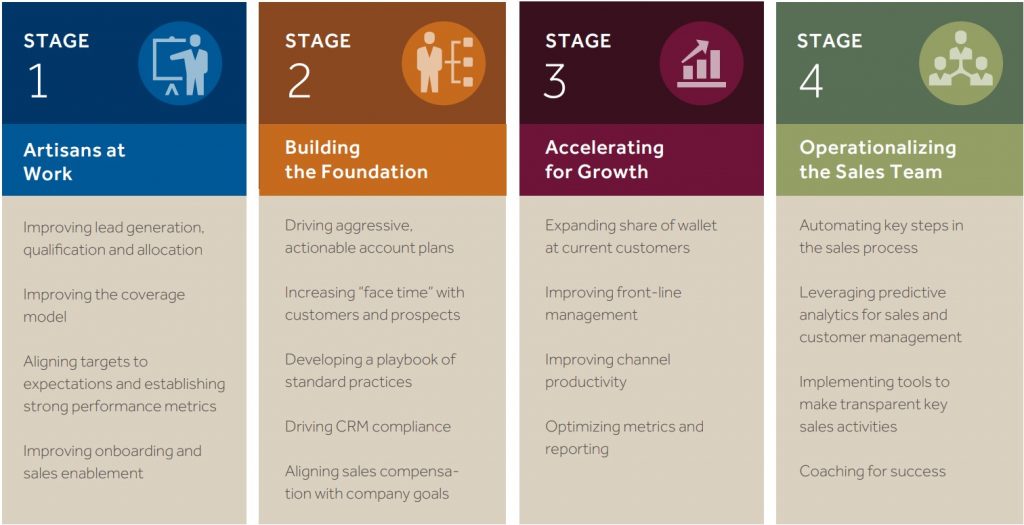Creating Predictability in Sales: How to Transform Sales From a Black Box to a Candy Machine
The CEO of one of our clients was frustrated by his inability to manage his sales organization:
“I put a dollar into the candy machine, pull the lever, and I get a candy bar. I put a dollar into the sales machine, pull a lever, and I have no idea what will come out.”
In most companies, the sales function has lagged other areas in the revolution of efficiency, transparency, and measurement that has taken place over the past 20-30 years. Functional areas such as operations, logistics, and finance have been streamlined and “operationalized” with repeatable processes that result in a consistent set of well-defined outputs from a given set of inputs. Seldom is this the case with the sales function. All too frequently, the inputs— sales talent, front-line management, enablement, and tools—produce inconsistent and unpredictable results, leading to unsatisfactory sales performance.
Many executives feel that there is something inherently uncontrollable about sales—that it is a “black box” and that any attempt to try to operationalize this function will scare away the best salespeople and doom the company to poor financial results. We emphatically disagree with this view. Gaining control of sales is not only possible, it is essential to sustainable top-line performance. Sales functions can and should be streamlined and operationalized to achieve the same levels of efficiency, transparency, and measurement that has become expected from the rest of the company.
A fully operationalized sales function is characterized by uniform, repeatable processes, a consistent management cadence, standardized toolsets (like CRM) used by all, and a detailed set of metrics that drive key business decisions. The result is a more predictable, transparent sales function that can be managed far more effectively and efficiently to achieve growth objectives. In short, it operates like a candy machine: when leaders put something in, they know exactly what they’re going to get out. The challenge is knowing where to start and how to get there. This challenge is compounded in companies that view sales as a “black box,” where reps are given free rein to generate sales in any manner they choose rather than being guided by a company playbook with repeatable processes that are aligned with company strategies.
The Four Stages of Sales Maturity
Every sales organization can become fully operationalized by taking the same kind of rigorous, scientific approach that has been used to drive improvements to other company functions. The first step is to understand the starting point. We typically see four stages in a sales organization’s development. These stages are characterized by increasing formalization of processes, metrics, accountability, and management, progressively leading to a more flexible and scalable organization that achieves improved growth rates.
Stage 1 (Artisans at Work).
In this stage, companies are dependent on a few superstar sales reps for most of their revenue. There are typically as many different sets of sales practices and behaviors as there are reps and managers, resulting in frequent (and often unpleasant) revenue surprises. Since the population of superstars in the market is limited, companies in this stage have increasing difficulty scaling the sales organization. Hiring junior reps into this environment of inconsistent, personalized sales practices typically leads to poor results and high turnover as new reps struggle to find their own way to meet targets. Sales organizations in the Artisan at Work stage seldom have any real sales management, and company-sponsored sales tools are used inconsistently, if at all.
Stage 2 (Building the Foundation).
As companies put more structure and systems in place to improve management of the sales function, they enter Stage 2. There is still a prevailing reliance on “gut feel” in decision-making here as salespeople are reluctant to change (especially the superstars!). However, onboarding becomes easier with the increased structure and companies can begin to successfully “grow their own” sales reps. There is some visibility into the pipeline in Stage 2, but no consistent sales cycle definitions and sales productivity remains highly variable. While stronger sales managers are now in place, each has their own view of what “good” looks like, so coaching is inconsistent and alignment with company strategies is hit or miss.
Stage 3 (Accelerating for Growth).
Companies entering Stage 3 have implemented standardized processes, developed a solid management foundation, and have begun to focus on accountability for results. Since metrics and processes are coordinated and largely adopted across the company, business decisions can be accelerated and performance challenges identified and addressed before they become problems. Sales reps follow company-directed sales practices in Stage 3, which allows companies to have far more flexibility in account and territory assignment. Performance is more visible and monitored daily, leading to less frequent revenue surprises and improved sales productivity. Sales management has developed a consistent cadence and is providing consistent coaching to their sales teams, so senior management can begin to see alignment between their strategies and action by sales.
Stage 4 (Operationalizing the Sales Team).
Companies in this peak stage are characterized by strong sales operational performance across a full range of indicators, including:
- End-of-quarter sales results within 10% of beginning-of-quarter pipeline forecast
- CRM routine compliance by 95%+ of the sales force
- Front-line manager ride-along and coaching compliance exceeding 95%+ of the sales force
- Front-line sales managers proactively use performance metrics as a management tool and systematically raise the bar for acceptable performance
- Consistent and transparent pipeline and performance metrics are used as the foundation for all sales-related business decisions, compensation, promotions, and exits
- Recruiting success at 70%+, measured as the proportion of new hires successfully onboarded and meeting performance goals within 6-12 months
- A focus on continuous improvement of all facets of the sales function, such as lead
- generation, account planning, pricing effectiveness, etc.
At each stage of maturity, there are different levers leaders can pull to improve results in the near term while increasing the repeatability and predictability of the sales function. For example, the approach to sales compensation will typically change as the level of maturity increases. In immature organizations, quotas are usually set individually based on last year’s sales, whereas a mature organization will apply a formulaic approach across all sales reps that is based on the opportunity of each territory, and compensation cost of sales (CCOS) calculations, and expected performance curves.
At each stage of development, there also are barriers to progress that must be overcome to avoid stalling and losing growth momentum. The sales functions of most companies get stalled in Stage 1 or 2 because they don’t realize the improvement opportunity available to them, they are concerned about the magnitude of the changes required, and/or they are not sure of the key steps they need to take to move forward. Stage 3 companies typically recognize the importance of continuing sales effectiveness improvement and we see organizations stalled in this stage less frequently. Maintaining the high-performance levels of Stage 4 requires continuous improvement to avoid complacency and keep the operational edge that will continue to drive accelerated growth.
Finding the “As Is” State
The starting point for operationalizing the sales function is an assessment of the current state of maturity. Executives can determine their “as is” state by exploring questions such as:
- Are high-powered individuals dominating our sales function or do we have broad-based success?
- Are salespeople selling what we strategically want them to be selling?
- Do we have sales managers who proactively manage, following the standard “Company Way of Selling” that is based on best-in-class management practices?
- Do we have the tools in place to give us the metrics we need?
- Do we have transparency into the sales activities and processes across the sales team?
- Do we have forecasting accuracy and pipeline visibility?
These kinds of questions help reveal a company’s current stage and the critical levers that must be pulled to move toward Stage 4. Blue Ridge Partners’ Self-Assessment tool, part of our Top Line methodology, can help structure the assessment, ensuring all areas are considered and helping to identify the most important opportunities.
In determining their “as is” state, one of our manufacturing clients asked themselves, “Do we have broad-based sales success across our regions?” The answer was a resounding no. While regional sales managers were generally making quotas, it was happening on the backs of a few strong sales reps, with everyone else in the regional sales teams performing well below expectations. This situation is typical of sales organizations in Stage 1 or 2. In this case, scant attention was being paid to helping the low-performing reps succeed while poor performers were being retained due to fear of creating open territories and damaging the manager’s performance. While each sales team could meet its targets due to the performance of the strong few, the organization was not scalable. Revenue growth stalled and then began to decline. Leaders realized the organization was stuck in Stage 2 and they needed a way forward to reverse performance.
Aiming for the “To Be” State
Once a company understands the maturity stage of its sales function, the next step is to lay out a roadmap for achieving the operationalized state, then to rigorously execute against this roadmap to improve sales effectiveness. Done right, these steps can really ratchet up performance. For instance, our manufacturing client’s realization that its sales organization was stuck in Stage 2 led to a concentrated focus on improving front-line management and coaching, better aligning quotas with expectations, improving the timeliness of metrics, and streamlining the hiring/onboarding process. By pulling these levers in sync with a coordinated roadmap, the company improved overall sales productivity by more than 10 percentage points and moved to Stage 3, Accelerating for Growth.
It is important to keep in mind that there must be a systematic approach to developing the roadmap. There are many interrelated moving parts that must be synchronized for the organization to progress without disruption. Racing ahead on one dimension without correspondingly improving others will not lead to overall success. Becoming world-class at lead generation, for example, doesn’t help if sales reps are not available or are not properly incented to chase the leads.
One of our clients had all the right pieces in place except one: the consistent use of a CRM system for managing sales activities and pipeline performance. Because of this gap, management was consumed with micro-managing activities, reacting to perpetual emergencies, and revising and reconciling inconsistent numbers rather than directing and coaching their teams to achieve stronger performance. Once senior management realized what was happening, they established a mandatory CRM compliance program: deals that were not properly entered into the CRM system didn’t exist and the salesperson was not compensated. This action got immediate results.
There is a wide assortment of interrelated levers companies can pull to drive improved sales operational performance. While it is certainly possible to pull any lever at any time, the level of maturity usually dictates whether there will be a positive return from pulling the lever. The following are examples of levers that, if pulled at each level of maturity, typically produce a positive outcome:

Without a clear understanding of the potential financial and behavioral impact of these actions and the interrelationship between levers, it is easy to make a false step and actually have a negative impact on revenue performance. That’s why a synchronized, comprehensive roadmap is so critical. It is also critical that a company seeking to travel down the path of operationalizing sales has the commitment and active participation of senior management before starting down that path. Leading a sales team toward higher stages of performance involves significant change. The strong support of everyone from senior management down through the sales manager ranks is essential to success.
While the journey to sales excellence is not easy, it is achievable with a plan and with disciplined execution. And in the end, the rewards in terms of sustainable revenue, EBITDA growth, and company valuation are well worth the effort.
How Blue Ridge Partners Can Help
Blue Ridge Partners specializes in helping clients accelerate revenue growth—it’s all we do. We are frequently asked to help companies establish the road map that will guide their sales operationalization efforts along a progressive path that drives continually improving results. Some of our clients have a good idea of where the best opportunities lie but need help in designing and implementing specific initiatives in the most effective manner without disrupting the current performance. We have a series of tools, diagnostics, and methodologies that we have developed to expedite the assessment and implementation process and more quickly achieve results. These include the Self-Assessment tool mentioned above which quickly provides an indication of relative sales maturity and an initial view of which levers will provide the biggest opportunities for profitable growth. We would be happy to help administer and analyze this survey at no charge as a way of introducing our firm and getting you started on the path to fully operationalize the sales function.


